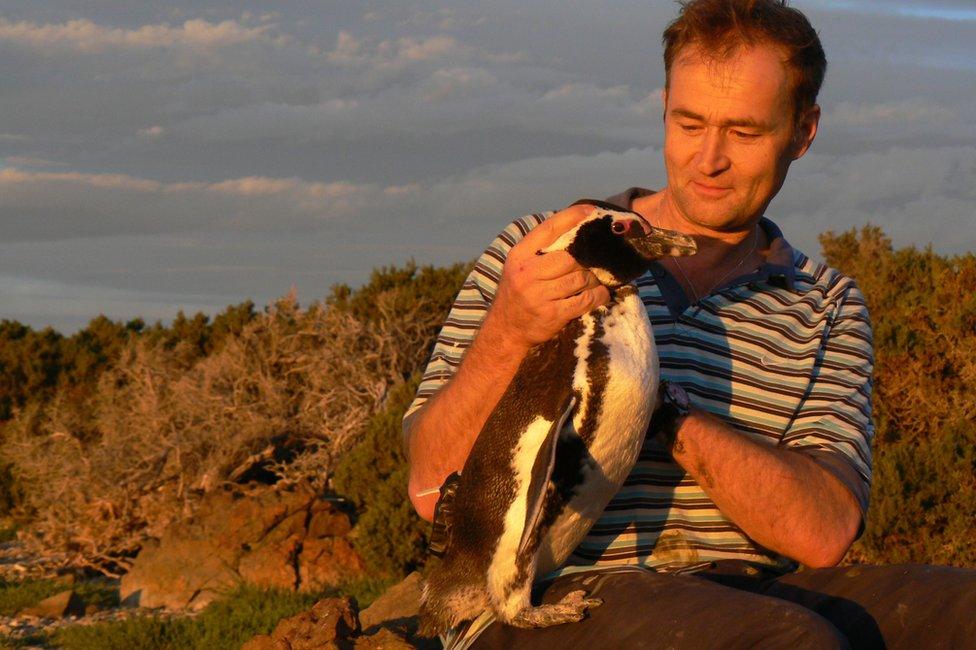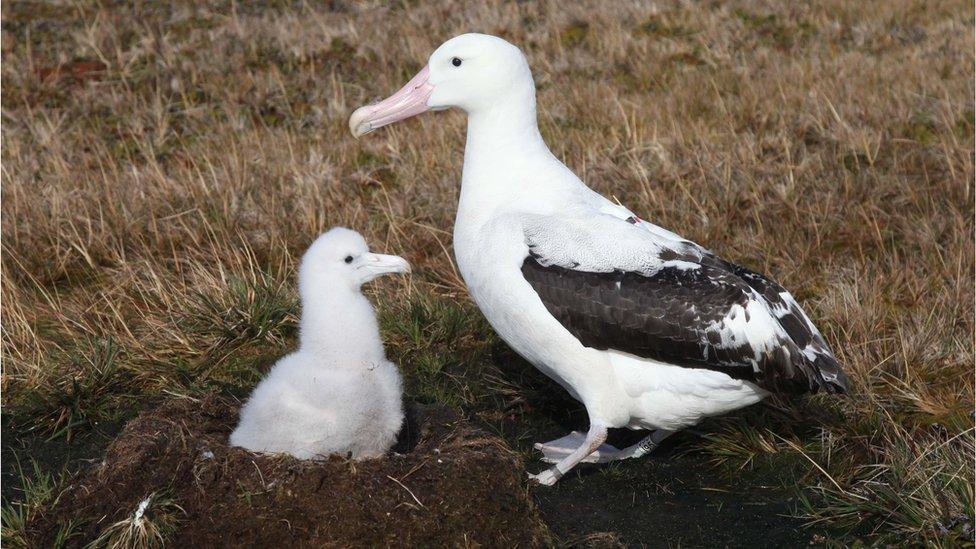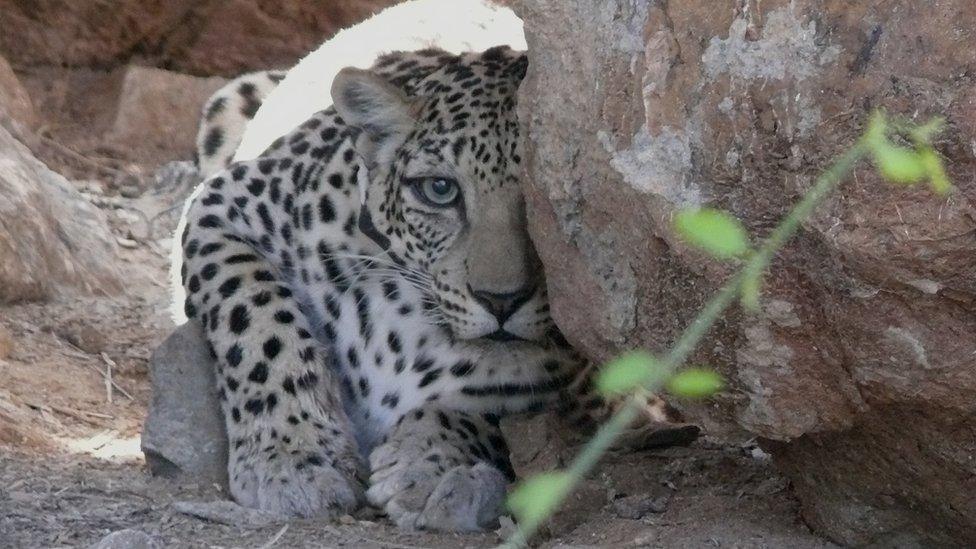Pioneering 'diaries' reveal the secret lives of animals
- Published

The researchers have monitored more than 1,000 individual animals
How do you tell if an elephant is having a good day? Or spy on the nocturnal squid-catching skills of the albatross?
This week at the British Science Festival, external, Prof Rory Wilson of Swansea University has been divulging the secrets of the animal kingdom, including penguin diving habits, albatross hunting methods and the emotional states of elephants.
"The problem with animals is we often want to know things about them that they don't want to tell us or that aren't easy to find out. The only way to do it is to put something on [the animal] that will accompany it," Prof Wilson said.
Leaving the bustling hub of the festival, which has taken over the Swansea campus all week, I was shown into the nerve centre of Prof Wilson's animal surveillance operation. The room is dominated by a huge, 2m-by-3m screen displaying all sorts graphs that wouldn't look amiss in a Nasa control room.
Addressing a crowd of journalists, Prof Wilson said his work was all made possible by a small electronic chip his team developed specifically to stalk animals in their private hours.
This chip contains accelerometers, magnetometers, pressure, temperature and light sensors - offering an unprecedented view of an animal's life.
The tag, Prof Wilson explained, essentially does exactly what our smartphones or fitness monitors do, continually tracking and recording the wearer's position and movements.
"This is a novel written by an animal. It's very exciting to be the first person to open that novel."
Watch the movement of a whale shark - as logged by a "daily diary" tag (video courtesy of Swansea University)
So far the group at Swansea has chronicled the lives of more than 1000 animals and 100 different species including penguins, cheetahs, sloths, albatrosses, elephants, cormorants and leopards.
"Our current understanding of animal behaviour is biased by what we perceive animals to be capable of, and what we see them doing," said Prof Wilson, alluding to a world of hidden behaviour.
"Elephant seals are big fat lumps of jelly on the beach, but become beautiful ballerinas in the sea."
Flight of the condor
Dr Mark Holton developed the data-logging chip. He showed me the team's original "daily diary", explaining how it was created to track the flight paths and energy expenditure of condors.
This earlier chip was about five times larger than the current version, which Dr Holton has shrunk to just 27mm across and 4mm thick - and weighing 1.2g.
"I love the challenge within this work, but with this original chip I pushed it right to the limit," he said.
"I only actually completed [the tags] at 18:30 the night before the researchers were flying out to put them on the birds."

The most recent "daily diary" design (lower left) weighs just 1.2g
The tags on the condors used technology normally found on the nose of an aeroplane to measure the flight velocity of these birds.
The data the group got back showed for the first time that the condors would regularly fly directly up into the sky, at staggering speeds of 47km/h (29mph).
Penguin parade
Prof Wilson said the whole enterprise was a team effort. His group consists of academics, postdocs and students, who spend months trawling through all the data collected by the tags.
Displaying results from a tag on a penguin in Argentina, he said the penguin was a personal favourite; he still analyses these birds' data himself.
Looking at the huge screen in Prof Wilson's lab and zooming in on regions of the tag plots, we could see the penguin's individual steps and flipper beats.

The penguins are a personal favourite for Prof Wilson
A change in movement and a drop in temperature pinpoints the exact moment of a dive into the water.
Several kilometres of swimming later, an explosion of movement on the graphs indicated the cleaning habits of the penguin, showing how it would roll in the water rubbing one flipper then the other.
Further observation revealed its diving practice and hunting manoeuvres; the penguin would glide to the surface, but suddenly dart back down with head movements signifying a catch.
Dazzling dance
The group regularly has moments of "Errrr, what's happening there?" Prof Wilson said, where they are left scratching their heads.
"The most surprising thing that we have discovered was from wandering albatrosses."
The general consensus, he continued, used to be that these birds would fly huge distances to find and eat dead squid, since such large birds would be unable to catch squid alive.
"We saw that the wandering albatross would swim at night in crazy circles for periods from 40 seconds up to seven hours, continuously, and then they'd suddenly be eating."

The tags brought to light previously unknown hunting techniques of the wandering albatross
Confused by this previously unobserved behaviour, the group eventually discovered that the birds were in fact luring the squid to their doom.
"What we think they're doing is, when it is very dark in parts of the ocean, they're swimming to agitate bioluminescent plankton, causing a bright glow. The squid, attracted like a moth to a flame, will then swim to the light and get eaten," Prof Wilson said.
"That's something that's really cool. It's one of those moments where you're flipping through the book and go: What?!"
Emotional elephants
The sensors within the tag are so accurate they can easily detect behaviours that humans might not notice - even offering insights into some animals' emotional state.
Think of the way we humans walk. If someone is happy, this can manifest in our physical behaviour - it is often said that they "have a spring in their step".
To observe if this sort of phenomenon also occurs in animals, Prof Wilson's team analysed the walking movement of elephants in a zoo.
They realised that an elephant walking towards something it liked, such as a mud bath or hay, would walk in a particular way. When that same elephant though was made to go away from the thing it liked, by a dominant matriarch, it would walk in a different manner.

Tags like the one on this leopard's collar can reveal otherwise hidden behaviours
Prof Wilson said he hopes to use the principle with wild elephants in Africa, which may exhibit stress in particular locations due to previous encounters with war zones.
"The implications of this for understanding animal state, and stress, are huge.
"The endgame for me is predicting animal behaviour. It would be lovely to say, that penguin is going to turn left down there, stop and rest for 12 minutes and then jump in the water.
"How well you can predict the behaviour of animals and animal movement is dependent on how well you understand the rules by which they're working."